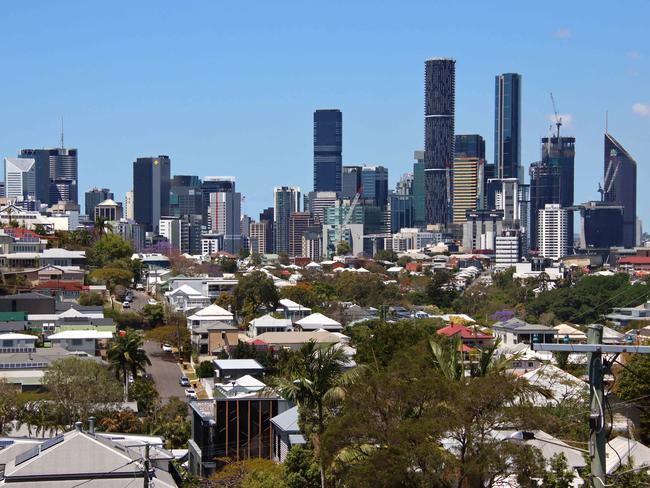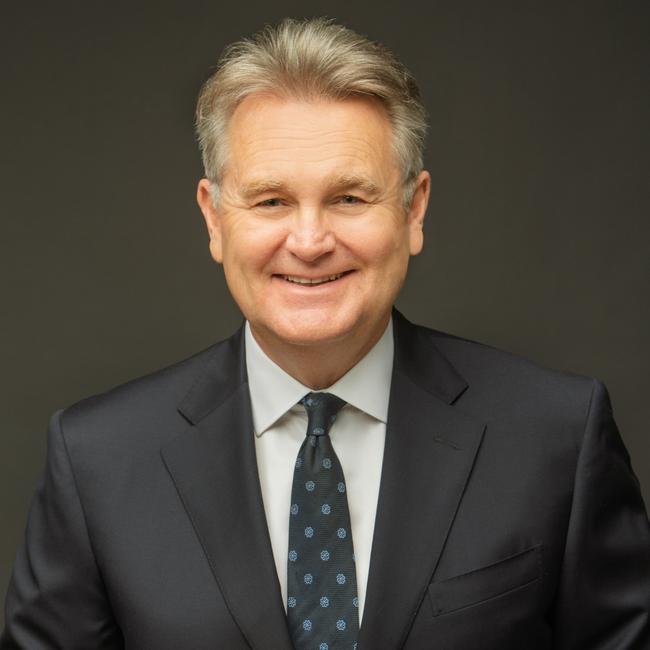Bernard Salt: What Brisbane 2032 will actually look like
Come with me on a journey to a future Brisbane, and indeed to a future Queensland at the time of the 2032 Olympics, writes Bernard Salt.
Opinion
Don't miss out on the headlines from Opinion. Followed categories will be added to My News.
Come with me on a journey to a future Brisbane, and indeed to a future Queensland at the time of the 2032 Olympics. What does this city, this state, the workforce — indeed the way we live — look like?
To have looked forward a decade at any point over the last 30 years would have yielded a “more of the same” prediction. More residents, workers, houses; more density because, well, building up is better than building out; more retirees, more students, more technology.
And while this more-of-the-same outlook may well have proven correct in the past I don’t think it will apply over the coming decade. I think Brisbane is passing through an inflection point. Here is a city and a people that is (metaphorically speaking) elbowing its way into the cosy coterie of global capitals — namely Sydney and Melbourne — that to date have shaped the eastern seaboard.
Projects like Cross River Rail and Queen’s Wharf will be completed. Many others are either shovel-ready or are in the pipeline.
In the years leading up to the Sydney 2000 Olympics the demography of Australia distorted. Skilled workers were drawn via interstate migration from surrounding states — Queensland, Victoria, South Australia and yes even New Zealand — into the building-frenzied vortex that was Sydney then prepping for the greatest show on earth.
It is inconceivable that Australia’s third Olympics — roughly one every third of a century —would go back to a southern capital. It was always going to be, had to be, Brisbane 2032. Although if I was the mayor of any Queensland LGA I’d be manoeuvring, deal-doing, right now to get a piece of the Olympics action: training, events, support, infrastructure, post-event wind-down. Paris 2024 is hosting its surfing competition in French Tahiti 12,000 km from the Champs Elyse. By this logic I reckon Cairns should put its hand up for, say, mountain bike riding?
It is time for Brisbane, for the greater state of Queensland to stamp its authority on this global event and in the process reshape the century-old Sydney-Melbourne-Canberra nexus to include, at the very least, South East Queensland.

But the next decade isn’t just about it being our turn at the Olympics; it should also be about being bold enough courageous enough to reimagine the way we work, live and interact in a post-pandemic technology-infused baby-boomer-retiring world.
And driving this mood for change will be the newest, the sharpest-edged generation to drive consumer spending. Over the coming decade the Millennial generation (born 1983-2000) will pass through their late-30s and into their early-40s.
Here is a time in the lifecycle when Australians are most likely to be partnered, to have young children, to pass through the peak-income-earning stage of the lifecycle (age 43).
This reverberation, this next iteration of the baby-boomer generation will underpin consumer spending this decade: new cars, houses, appliances, holidays, loans. As soon as the Millennials’s kids evolve from cute but immobile babies to an unstoppable run-around toddlers their thinking will change.
This transition will surely drive a surge in demand for what might be termed the lifestyle home, the ‘forever’ home: three bedrooms, two bathrooms, front garden, backyard… and a Zoom room. And the reason why a Zoom room is required is because tech-enabled knowledge-worker Millennials, much like every preceding generation of Australians for a hundred years, are motivated by the pursuit of lifestyle.
Brisbane transforms as a consequence. The energy of the CBD and the groovy inner city is replicated across middle and outer suburbia and even into the lifestyle zone beyond. Returning soldiers in the 1950s embraced the quarter-acre block because, well, they adjudged suburbia, even with its necessary commuting, as delivering a better quality of life.
Do you really think technology-enabled Millennials conscious of the need for value-for-money housing, disinclined to anything that might worsen carbon emissions, will support the idea of commuting to and from the city centre for the next 30 years of their career? No! There’s a better way of organising the way we live and work.

Now is the time to be forthright and ambitious in constructing a way of life that delivers better outcomes for all. These big-picture lifestyle and behavioural shifts are already evident, nascent. Out with waiters, in with QR codes to order meals. Less in-store shopping more direct-to-home deliveries. Who had heard of click-and-collect prior to the pandemic?
Want to know the hottest business activity of the coming decade? That is, apart from aged care? It is logistics. It is the business of getting product from the producer to the home. This business was revolutionised in the 1960s with the advent of the suburban shopping centre and the rise of the motor vehicle.
Today, and into the future standard products of a known quality and function, as well as other quite random product, will be ordered and delivered online. Brisbane—and all other major cities—will have, must have logistics facilities equivalent in scale and impact to today’s major suburban shopping centres.
The much-maligned CovidSafe app, for all its cost and apparent failure to track the coronavirus, did make an important contribution to Australian productivity. It taught (often older) Australians how to download an app. And we haven’t looked back. The “great appification” will reshape the way customers interact with service providers.
I don’t know about you, but I’d prefer to app-it rather than wait online for a call centre operator. It’s just one way in which everyday life has changed, is changing.
There are other transformations that are quite unique to Queensland. The 2021 Census for example shows that three-quarters of beef cattle graziers are aged 50+; more recent data suggests that many (most likely baby boomers) are leaving the industry. A transformation on the horizon is the corporatisation of the family farm and especially west of Queensland’s Great Divide.
Future Brisbane is an opportunity to take the time to reflect upon the challenges (eg affordable housing, renewable energy, possibly social cohesion) that confront Australians both now and into the future. With the right planning it is possible to mitigate risk, and to deliver a better, a fairer, and a more prosperous Brisbane throughout the 2020s.
The next step is public engagement: what are your thoughts on the future of Brisbane?
Bernard Salt is founder of The Demographics Group and speaker at Friday’s Future Brisbane event at Howard Smith Wharves
Read related topics:Future Brisbane



